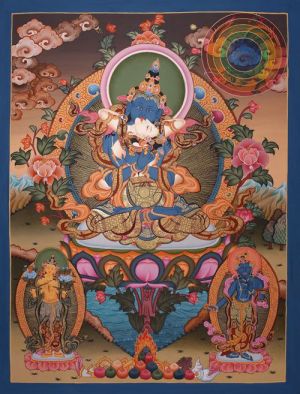Tibet - bca’ yig
In Tibet, texts that contain rules on life in the monastery are generally called bca’ yig, although a plethora of names exists for texts that in some way deal with monastic organization of the monastery.
One also finds works that are labeled bca’ khrims, rtsa khrims, bka’ khrims, bca’ sgrig, sgrig yig, sgrig gzhi, khrims yig, tshogs gtam, and sgrig lam: all may contain rather similar information.
The earliest extant work containing instructions for a monastic organization stems from the late 12th century. This first bca’ yig-like text contains prescriptions for aspects of monastic governance and consists of instructions given by Lama Zhang (i.e. Zhang Brtson ’grus Grags pa [1123–1193]), written down and preserved in his collected works (Tib. Gsung ’bum; Ellingson, 1989, 208).
According to tradition, it was recorded as an oral testament directed to his successors at the monastery of ’Tshal gung thang. It is said to have been spoken when Lama Zhang was close to dying, thus either in or before 1193.
Even though it contains some valuable information on monastic organization in the late 12th century, the monastic guidelines developed into a more established genre only by the 14th century.
Just like the terms kriyākāra and katikāvata, the word bca’ yig, which previous scholars have connected only to monastic regulations, may also apply to non-monastic groups, such as lay people in retreat or tantric practitioners. Some rulebooks that bear this name even serve to guide lay communities and are more or less secular in nature.
Whereas the lion’s share of texts containing monastic rules in Sri Lanka were issued for the entire monastic community and while East Asian texts consisted of rules mostly intended for one single school, the rulebooks in Tibet more often than not were written for one single monastery.
Monasteries with thousands of monks, which were almost cities in their own right, as well as small hermitages deep in the mountains, had such written rules.
The traditional claim is that each monastery of some renown needed to possess at least one set of guidelines (personal communication, July 2012). Interestingly, the surviving bca’ yig written for nunneries are far and few between: I have counted three so far (Jansen, forthcoming).
Monastic guidelines written for Tibetan monasteries can abound with local flavor and interesting details, a sign that they were written by someone invested in the monastery, often an abbot or an important incarnation stationed there. This literature can also be very generic, particularly when writ- ten by one less involved in the monastery. Just as in the Sinhalese context, in Tibet monastic rules were sometimes tools of the state.
These particular bca’ yig have the aim to restructure the monastery’s religio- political alliances and often contain rules for monasteries that are both physically and “religiously” far removed from the author’s effective power.
Examples can be seen in the works of the fifth Dalai Lama (1617–1682), who wrote a bca’ yig for a Bon monastery, and in those of the thirteenth Dalai Lama (1876–1933).
The latter composed at least 38 monastic guidelines, almost all of which were intended for monasteries outside of central Tibet – that is to say, beyond the direct rule of the Tibetan government (Thub bstan Rgya mtsho, vol. IV, 1981–1982).
These monasteries presumably already had monastic constitutions of their own, but issuing these constitutions was to a great extent a political act, a way to draw monasteries – mainly located in Kham and Amdo, regions that were not well-known for their allegiance to the central Tibetan government – into the political and religious sphere of the Dalai Lama.
The texts themselves often explicitly state their local and contemporary purpose.
An example is the bca’ yig written for all Sikkimese monasteries in 1909, in which it is said that it is a work “in accordance with all the monasteries’ own rules, the local customs, [people’s] dispositions, capacities and intentions” (Jansen, 2014; Schuh & Dagyab, 1978, 269–270).
We can see that when structural changes took place in a particular monastery – for example, when it changed affiliation or had been rebuilt after destruction, or even when the education program was expanded – the bca’ yig of that monastery was seen to be in need of revision or replacement.
This is not unlike the notion prevalent among the authors of the katikāvata: some of these Sinhalese monastic codes state that they were renewed in accordance with the changing times (Ratnapala, 1971, 164).
